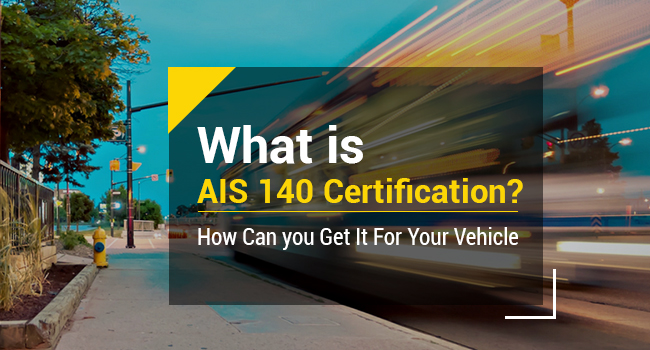It will not be an overstatement to quote that the economy of a country is majorly dependent on the efficiency of its transportation system. Termed as a backbone for any developing country, the transportation system is ordained to work to its full potential at all times.
A breakdown of your transport system is bound to throw your business out of gear, causing you irrevocable losses.
Given the significance of transport system to the growth of the country’s GDP, Indian government has come up with an Intelligent Transport System (ITS); a segment of Automotive Industry Standard (AIS) 140.
Below is the rundown of various ways in which public and private vehicles are made safe and efficient by adhering to the prescribed norms of AIS 140 certification.
Before you understand what the AIS 140 certification has in store for vehicle owners, it is important that you know about the recent April 2018 mandate that was released by the Indian government.
The Indian Government’s Mandate of April 2018
According to the mandate released by the Indian government, AIS 140 certification is mandatory for public service vehicles including public and private transport buses, taxis, cabs and transport buses that ferry employees.
Last but not the least, the bright yellow colored school buses are also instructed to get an AIS 140 certification. Through this AIS 140 certification, vehicle owners will meet all the specifications revolving around the safety, comfort, quality of service and efficiency.
The mandate made it imperative for these vehicles to be fitted with vehicle tracking devices and emergency buttons by 1st April 2018.
Seen as a revolutionary move on part of the Indian government to ensure the efficiency of both private and public vehicles, the April 2018 AIS 140 mandate thus brings in a perfect blend of camera surveillance, vehicle tracking and emergency request processing systems for the combined benefit of fleet owners, drivers and passengers as well.
The Benefits of AIS 140 Certification
Offering an AIS 140 complaint transport system is a welcome step for the following reasons.
All the above categories of vehicles will come under the mandate of AIS 140 and will be attached to a vehicle tracking server manned by the Indian government.
The Indian government has plans underway to establish a host of authorized servers in every city streamlining a number of functionalities. Gaining strength from a cloud-based data storage, vehicle owners can make the most of the real-time vehicle updates coming from a tracking device that is fitted to their vehicles.
The AIS 140 certification brings to the table a host of features. These are:
1. A Strong Vehicle Tracking System– This is one of the most significant features of AIS 140 certification. Through an automatic vehicle location tracking system, you will be in a position to monitor every trip your vehicle takes.
You will not only be informed about how you can optimize the consumption of vehicle fuel but also have data points substantiating the punctuality of your fleet regarding arrival and departure timings.
2. Efficient Management of Routes and Transport Schedules – The AIS 140 certification provides enough room for the efficient management of vehicle routes and their scheduling. The device can help you cut down your fuel expenditure by suggesting the shortest route to reach your destination.
3. An SOS Button During Crises– These vehicle tracking devices which are AIS 140 compliant come with a click-to-activate button which will help drivers during an emergency. Once an emergency information reaches the emergency response server, precautionary instructions will soon come your way.
Tagged as an AIS 140 Panic Button, passengers on board or the driver can activate this button during a crisis so as to send an emergency alert to the Government’s Command Center.
4. An Effective Tool To Manage Your Crew – The AIS 140 mandate is an ideal way to keep a watchful eye on the behavior of drivers while they are at the wheel. With an AIS 140 telematics system fitted to your vehicle, you can have a watchful eye on the sudden braking instances and the over-speeding metrics.
All such instances when a driver initiates a rash turn will be recorded and shared with you in the form of MIS reports.
5. Tampering Alerts – The telematics device will pop up an alert when your vehicle tracking device is being tampered.
6. Vehicle Health Advisor –The AIS 140 certification can become the barometer of the condition of your vehicle. The device embedded with a Vehicle Health Monitoring & Diagnostics tool can ensure the health of your vehicle at all times alongside allowing you to predict the possibilities of wear-and-tear that can cause transport breakdowns.
7. Safety of Passengers Paramount – In an attempt to ensure the safety of passengers onboard, an AIS 140 tracking device fitted to your vehicle will provide you with in-house video recording.
It is through this constant surveillance that you can ensure the safety of your passengers at all times. You can also get location-based announcements.
Coming to the next question of this blog, you will now learn about the preliminary steps that should be taken by you so that your fleet is bestowed with the AIS 140 certification.
How to Get Your Vehicle the Much-Needed AIS 140 Certification?
In order to ensure compliance to the AIS 140 guidelines to get your vehicle AIS 140 certified, you as a vehicle owner should fit your vehicles with a GPS tracking system along with a camera surveillance and emergency request button.
It is through these safety and monitoring gadgets that the Indian government can track any bus.
Allowing the control room to have hands-on information of what would have caused a mishap, it is through the AIS 140 guidelines that you can ensure the safety of your passengers.
As per the directive, both the existing and the upcoming vehicles should be equipped with GPS tracking systems and emergency buttons. That makes it imperative for automobile OEMs (other equipment manufacturers) to start the production of these vehicle tracking and safety devices.
Closing Thoughts
It will not be an exaggeration to state that the Indian government has taken a big leap towards ensuring the safety and efficiency of its transport system.
Once the AIS 140 directives are brought into total compliance by all the public and private vehicles plying in all the Indian cities, it will be time for the implementation of Advanced Driver Assistance System (ADAS) and Augmented Reality (AR).
The day is not far when these two technological advancements linked to the transport system will soon become inevitable functionalities with every vehicle under the radar of the Indian government.












